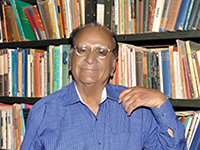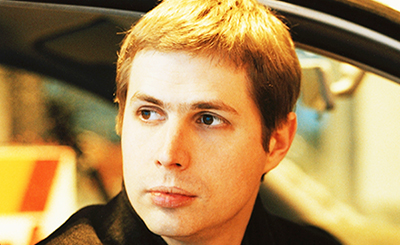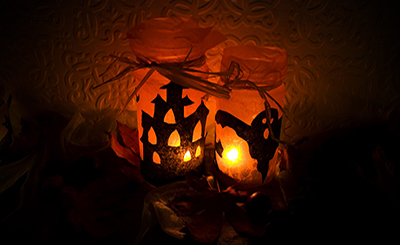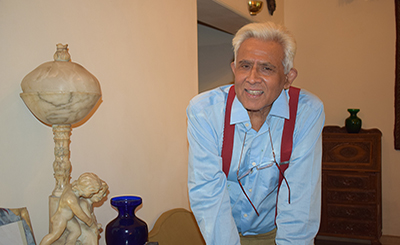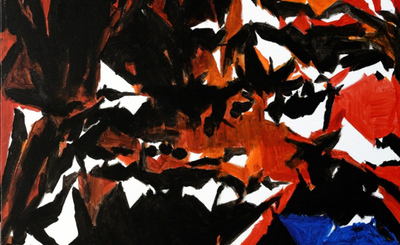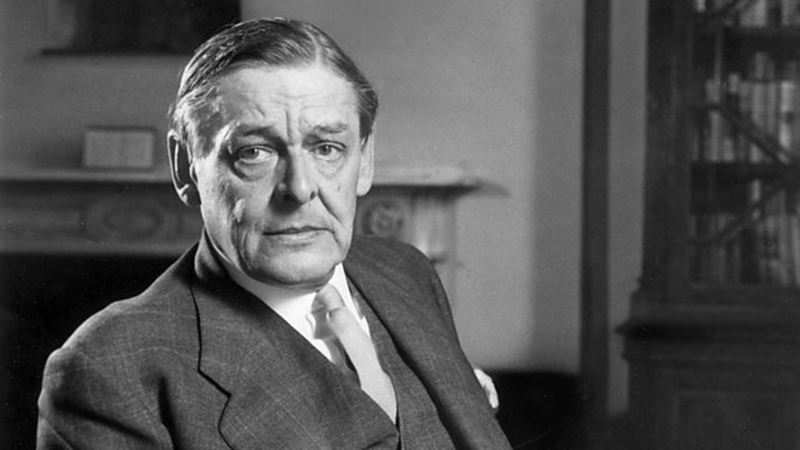
TS Eliot. Photo courtesy: BBC
A rare and unpublished conversation with T S Eliot (1888-1965) by Prof Shiv K Kumar (1921-2017). Before his death, Prof Kumar had graciously given The Punch the permission to publish it
Thomas Stearns Eliot was born on September 26, 1888, at St. Louis, Missouri. He had his early schooling at Smith Academy. During his stay at the Academy, he started writing poetry at the age of fourteen, under the influence of Edward Fitzgerald, known for his translation of Omar Khayyam’s Rubaiyat. But since he was utterly dissatisfied with his verses, he destroyed them (one of his earliest poems was titled “A Fable For Feasters”). He also wrote a few short stories, including “The Man Who Was King”. Later, he went to Milton Academy in Massachusetts.
After working at Harvard as a philosophical assistant, he went to Paris, and studied Philosophy under Henri Bergson at the Sorbonne. After completing his study in Paris, he returned to Harvard and studied Indian Philosophy and Sanskrit. He was awarded a scholarship for further studies at Merton College, Oxford, UK. During his stay in England he met a young English girl, Vivienne Haig-Wood whom he later married. They moved into a flat in London where he came in contact with Bertrand Russell who started an affair with his wife.
Haig-Wood often lapsed into long spells of frustration over her marriage with Eliot. Her depression seeped into Eliot’s life who also began to feel utterly disillusioned about the world around him. It was this feeling of alienation from life that drove him into writing his famous poem The Waste Land which is a comment on the decadence of his times. He showed this poem to Ezra Pound who slashed it down to one-third its original length. Incidentally, he regarded Ezra Pound as “Il miglior fabbro”, “the Greater Craftsman”. During his stay in London, he became Director of Faber and Faber where he had a love affair with a young secretary aged 32, Ms. Esme Valerie Fletcher, whom he married secretly at the age of 68. A wall plaque commemorates him with a quotation from his poem “East Coker”: “In my beginning is my end. In my end is my beginning”. During his stay in England, he acquired British citizenship. He was honored with the Order of Merit, Légion d’Honneur, and later conferred the Nobel Prize for Literature in 1948. His poetry collections include The Love Song of J. Alfred Prufrock, The Waste Land and Four Quartets. Among his plays may be mentioned: Murder in the Cathedral, The Family Reunion, The Cocktail Party, The Confidential Clerk and The Elder Statesman. His critical writings include Collected Essays.
Eliot died of emphysema in London on January 4, 1965 at seventy-six. Eliot is a poet for the erudite, not the general reader. No wonder, “The Lemon Squeezer School of Criticism”, (to borrow Eliot’s own phrase), has thrived on churning out commentaries on his poetry, particularly The Waste Land which carries as its appendix a list of the sources for this poem. The scholarly reader, therefore, finds it more exciting to go to such sources as The Tibetan Book of The Dead, The Brihadaranyaka Upanishad, The Dhammapada and St. Augustine’s Confessions. Very few readers are inclined to read the poem itself.
I was drawn to Eliot for his India connection. I learnt that Eliot had studied Sanskrit at Oxford and later philosophy at the Sorbonne in Paris where Bergson was Professor of Philosophy. I, therefore, wrote him a letter enquiring if his concept of time in The Four Quartets was influenced by this philosopher. I was impressed by his prompt response, but was intrigued by his manner of addressing me.
As I looked closely at the letter, I visualized Eliot as a white-collared gentleman with a colonial mindset who addressed every correspondent as Esquire and not as Mr. or Sir. I understood that Eliot was a writer who didn’t want his ego to be deflated by any reference to his being influenced by Bergson. While acknowledging that he was Bergson’s student, he added that he had outgrown his influence. He went on to say that any trace of Bergson should be taken as subconscious. Then why did he, I wondered, preface his The Four Quartets with a quote from Heraclitus: “You cannot step into the same river twice, as the waters have flowed.” This is also the central credo of Bergson’s philosophy which looks upon life as “le flux ininterrompu”, the ceaseless flow of life. He stressed that human life is a process, and not a state. In other words, all human beings are caught in the continuous process of becoming.
I wrote to him, seeking an appointment with him. He replied, inviting me to tea at his office at Faber and Faber. When I reached there, I found that the publishing house was a large establishment of three floors where Eliot’s office was on the second. Quite nervously, I knocked at his door, and a genial voice greeted me, “Come in, Mr. Kumar.”
There was Eliot seated behind a large mahogany table. I saw a man in his late fifties, with neatly groomed hair, a starched shirt and a red tie. He held out his right hand and said, “Most welcome.” I stood there, overwhelmed by the man I was waiting so eagerly to meet. After I sat in the chair, we got talking.
“To start with, didn’t I answer your question in my letter about Bergson’s influence on me?” asked Eliot.
“Yes, sir, you did,” I replied. I noticed that his desk was neatly arranged with a pile of files to his left, and another pile of manuscripts to his right.
After a pause, I resumed, “How do you like being a director of a publishing house while you are essentially a creative writer?”
He responded with a smile, “I have to earn my living. My writings don’t bring me enough to keep me going.”
“Sir, I’d say that The Waste Land alone, a tour de force in modern literature, should sustain you all your life. I’ve read it a dozen times, and each time it unfolds a new dimension.”
“You are being very magnanimous. Yes, I enjoyed writing the poem.”
“May I ask you, sir, how long did it take you to write this poem?”
“Oh dear, it took me a whole lot of time. The original draft ran over a hundred pages, but Ezra Pound slashed it down to one third. He did a marvelous job of editing and I should remain grateful to him forever. This poem, you know, is dedicated to him as the greater craftsman — Il miglior fabbro.”
“But isn’t there a difference, sir,” I interposed, “between a creative writer and a craftsman? I’ve read Ezra Pound’s Cantos and I think there’s more of artifice in it than creative imagination.”
Eliot smiled., “I feel you are being a little unkind to Ezra Pound who is like my guru.”
I said, “You know how reverential we Indians are towards our gurus. But isn’t it also true that the disciple may sometimes excel his master?”
“Let’s leave it at that,” said Eliot gently.
It took me a little while to ask him the next question. “I don’t know if any other British poet is as versatile as you. I was particularly interested to know that you did Sanskrit at the graduate level, and then went deep into Indian philosophy. So I think you must have read the Upanishads and the Gita in Sanskrit. But did you go as far as Pali since The Fire Sermon carries the essence of the Dhammapada?'
“No, I do not know Pali. Nor have I read all your Upanishads. You may have seen from The Waste Land that I closely study only to the Brihadaranyaka which awakened me to a new mode of thinking.”
“Sir, I have noticed it was your Sanskrit background that made you conclude The Waste Land with the invocation, Shantih, Shantih, Shantih.”
Eliot nodded his head. “I wish I could have expounded the word Shantih as the peace that surpasseth all understanding.”
What he said set me thinking. I said deferentially, “I am indeed amazed by your comprehension of a word which has not been adequately understood even by our scholars.”
Eliot smiled gently. “There you go again, Mr. Kumar, placing me on a pedestal I don’t deserve.”
Hesitatingly, I said, “I should like to ask you one question that intrigues me. You are distinguished both as poet and critic. My favorite critical essays by you are, ‘The Function of Criticism’, ‘Tradition and the Individual Talent’ and ‘Frontiers of Criticism’. I paused for a moment. “Sir, does your critical faculty come in the way of your creative writing?”
Eliot was lost in thought for a while..
“No, both creation and criticism are coterminous.. I think I have explained in my essay, ‘The Frontiers of Criticism’ that a creative writer is also his own critic. In the process of creation, the poet uses his critical faculty to expunge, modify or change a word.” Eliot leaned forward. ‘Let me answer a question you haven’t asked me so far. Which is my favorite genre — criticism, poetry or drama? My first love is, of course, poetry, ,and every other form of writing is secondary.”
At this point, I felt very diffident to say what I thought might cause him discomfiture. I had in mind his poem The Love Song of Alfred J. Prufrock. Why does his poetry often sound too cerebral, lacking in emotional intensity. So I asked him, “Sir, why is most modern poetry too cerebral?”
“You are perhaps referring to my magnum opus, The Waste Land,” he said. “But never mind. Speaking for myself, if this poem, The Hollow Men and The Love Song of Alfred. J Prufrock sound sterile to some readers, it is because I want to present the contemporary man in his true form. Don’t we live in an age which is a wasteland where nothing grows except briars and brambles? There are no longer roses or marigolds around us, only cacti. So you can say that my poetry holds a mirror to contemporary reality.” He took a deep breath and looked askance at me.
“But you Indians hold a different worldview because you love life in a full-blooded way. I can imagine an Indian reader like you feeling disillusioned about our civilization. Let me tell you I’ve read your Indian classic Kamasutra, a wonderful exposition of the art of making love. I’ve also read about the erotic sculptures of Konark- and Khajuraho, which you call temples. This is what makes your civilization holistic. This is because only in India you find a unique fusion of body and soul.”
I bowed to him. “I humbly accept your tribute to Indian civilization. Sir, if I may tell you, the great sage Vishwamitra symbolizes the confluence of renunciation and sexuality.”.
Eliot became thoughtful. “Yes, I’ve read about the Vishwamitra episode. As a matter of fact, I was introduced to Hindu scriptures by Max Muller, the great German Indologist.” He paused. “But I was told by my Sanskrit Professor at Oxford that Max Muller’s hold on Sanskrit was not too firm. Anyway, that’s another matter.”
There was a brief silence. I felt that it was now time for me to leave. As I got up, he waved to me to sit back in the chair. Then in a genial tone, he said, “May I ask you to stay with me just a little longer? I want to tell you, there are a couple of things in the Gita that confound me. Since you are a Hindu, I should like to know your opinion about the Gita. You may have noticed in my poem Dry Salvages, where I have said, “I sometimes wonder if that is what Krishna meant.” I was only expressing my disagreement with a basic tenet of this great scripture. I somehow cannot bring myself to justifying Krishna’s exhortation to Arjuna on the battlefield to kill even his own kith and kin. I tried to find the logic behind this. On the contrary, I tend to think that whatever be the reason, destruction of life is unpardonable. If God is the Creator of life, man has no right to eliminate it. Let me seek your pardon once again, Mr. Kumar, if you find my statement blasphemous.”
I nodded. “I fully agree with you, Mr. Eliot. The very sight of blood scares me. I had a painful experience in Calcutta when I went to visit Mother Teresa’s Home for the Destitute. It was at the famous Kali Temple with the idol of the goddess in her fierce posture installed inside the sanctum sanctorum. I saw a devotee carrying a little lamb some distance away and slitting its throat. He then carried the blood in his right palm, returned to the sanctum sanctorum and smeared the goddess’s forehead with it. I have not been able to erase that scene from my memory.”
For a couple of moments, I saw Eliot musing with his eyes closed. His right hand trembled. I felt he shared my pain over the slaughter of an innocent animal. Eliot said thoughtfully, “Mr. Kumar, you have not only answered my question about The Gita, but have also reinforced my belief in the sanctity of life.” He again closed his eyes for a moment and then broke into words. “You know when Hegel read this scripture, he threw it away, saying that it is caste-ridden. Why did Krishna grade human beings in four categories: Brahmin, Kshatriya, Vaishya and Shudra? Isn’t such categorization likely to generate social discord? I hope you’d agree with me that if birth is an accident, it should not be allowed to label a person as belonging to one caste or another.”
“You are absolutely right, Mr. Eliot.”
He was silent for a moment. “Mr. Kumar, you may have read the Dhammapada. If you recall, in the last section of this book, the Buddha denounces all social barriers. According to him, if a shudra leads a righteous life, he can also attain Brahminhood. No wonder, in recent years, the so-called untouchables have embraced Buddhism to seek social salvation. To them, the Buddha is a savior who promises dignity and justice. As for Christianity, it may not be the only religion blessed by God, but it accepts equality as its central credo. But let me conclude by saying that in spite of disagreement with a couple of things in the Gita, this scripture remains one of the greatest books ever written.”
“Sir, I thank you for making me feel that we both are on the same wavelength.”
As I stood up to leave, he led me to the door and said, “It was wonderful spending some time with you.”
More from The Byword
Comments
*Comments will be moderated



